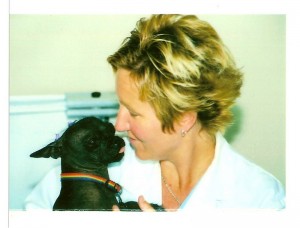by Teresa Garden, DVM

Back in the dark ages (before laptops, i phones, i pods) when I was just a wee vet student, we learned there was a new entity in feline medicine called “hyperthyroidism”. It was very uncommon so, of course, we were taught and tested about it constantly and then told we would rarely see it in practice. Fast-forward twenty-five years to the digital age (and more wrinkles and gray hair) and, lo and behold, hyperthyroidism is a disease we now see commonly in middle-age or older cats.
Why is this?
Numerous factors play a role. Cats are living longer and pet owners are seeking medical treatment for them when they appear sick. Veterinarians are now able to diagnose this disease by running routine blood tests yearly on our middle-age and senior cat patients. Environmental toxins (cat litter) and dietary additives may increase risk to the disease. Due to these factors, hyperthyroidism is now the most common endocrine disease in cats.
What exactly is hyperthyroidism? It occurs when the thyroid gland “over-functions” due to the presence of a tumor or hyperplasia (increased number of cells in the tissue). When the thyroid is in the “hyper” state, it increases the metabolic rate in the body. This leads to the classic symptoms of hyperthyroidism that pet owners will readily recognize. These cats will lose weight in spite of a ravenous appetite. They are anxious, nervous, vocal, drink a lot, urinate a lot, vomit, and have frequent, loose stools or diarrhea. Their haircoats may be greasy, matted or unkept. Their heart rate will be elevated and breathing may be increased or labored. Hyperthyroidism can be associated with other diseases such as food allergies, IBD, cardiomyopathy, and hypertension. If hyperthyroidism is successfully managed then cardiac function may improve and hypertension may resolve. If underlying issues such as food allergies and IBD are addressed then symptoms of hyperthyroidism will regress.
The goal of any treatment modality is to achieve a euthyroid (normal thyroid) state. At Animal Health & Healing we focus first on dietary therapy. If cats are eating commercial foods, we slowly transition them to a natural diet to minimize exposure to toxins and food additives. Natural diets are higher in protein and fats and lower in carbohydrates which provide better nutrition to help maintain body weight and muscle mass. Low carb diets may help to prevent hyperthyroidism as well. If cats are thought to suffer from IBD or food allergens, then avoidance of these allergens is of paramount importance and may be achieved by feeding limited or raw diets. From a TCM (Traditional Chinese Medicine) perspective, hyperthyroidism is viewed as a GI disturbance. If GI symptoms can be controlled through diet then symptoms of hyperthyroidism will lesson. After dietary issues have been addressed, we next decide what other treatment modality should be employed to help our patient. Other treatment options include western and eastern herbs, glandular support, radiation, surgery or the drug Methimazozle.
If clients are looking for holistic treatment and if disease has not greatly advanced, then herbs may be tried. We use a proprietary blend of rehmannia, curnus fruit, dioscorea root, poria, motuan bark, alisma, anemarrhena, phellodoendron, vervain, bugleweed, and stevia made by D’Arcy Naturals. This is an herbal powder which can be mixed with canned food. My own cat, Caitlin, did very well on it for a number of years. Feline Whole Body Support is a wonderful glandular supplement made by Standard Process which we often recommend for our hyperthyroid patients. Holistic treatment may successfully control the disease or at least lessen the amount of the western drug Methimazole needed to manage hyperthyroidism. Methimazole is probably the most common treatment modality used today. It is available as a pill or as a transdermal gel which is applied to the cat’s non-haired part of the ear. Since Methimazole has to be given daily for the lifetime of the cat, most of our clients opt for the transdermal gel due to its ease of use. In most cases it is effective. Methimazole is the first choice of treatment for a cat that has both hyperthyroidism and renal disease. The drug can be used at a level to keep the thyroid hormones slightly above the normal range to help maintain renal function. The newest form of treatment is the subcutaneous injection of the radioisotope Iodine-131. This may be the ideal permanent treatment of choice for kitty patients with normal renal function. I-131 is a beta radiation emitter that kills hyper-functional thyroid follicle cells and cancer cells. The advantages are one injection is curative in 95% of cats, side effects are negligible and it is not invasive. The disadvantages are it requires hospitalization for 3-5 days and it can cause hypothroidism in 1-2% of cats. The initial financial outlay for radioisotope therapy is expensive, but costs for other treatment modalities are comparable over the lifetime of the pet.
Hyperthyroidism is a disease that compromises almost the entire body. Its detrimental effects extend to the muscular, nervous, respiratory, cardiac, GI, and urinary systems. The goal of early diagnosis and treatment is to prevent damage to the body. The disease can be managed with diet and medical therapy. This approach will require monitoring the pet every 3-4 months by performing exams, blood tests, and checking blood pressure. Radioisotope therapy is curative, therefore, long-term monitoring will be minimal.
Dr. Teresa Garden is chief veterinarian/owner of Animal Health & Healing, a full-service holistic and conventional veterinary practice in the Maplewood/Richmond Heights area. AnimalHealthandHealing.com; phone: 314-781-1738.


